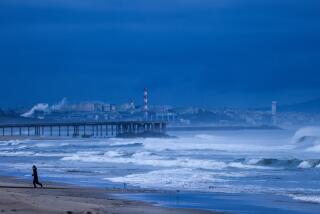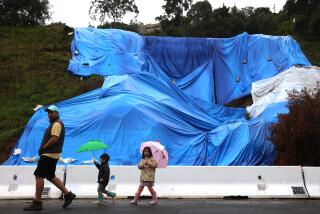Winter Storm Delights Ski Resorts but Afflicts Lowlands
The first major winter storm of 1987 blew into Southern California from the Gulf of Alaska on Sunday, bringing a much-needed balm of snow to mountain ski resorts--and the predictable plethora of traffic accidents, mud slides and power outages to the lowlands.
A winter storm watch was issued for Sunday night and this morning for heavy snow accompanied by gusty winds and poor visibilities in mountain areas above 4,000 feet, and travelers’ advisories were in effect for possibly heavy snow in the Owens Valley north of Big Pine.
The National Weather Service said an upper level low pressure area centered about 230 miles west of Los Angeles was moving slowly eastward, in association with a moist and unstable air mass containing numerous showers and thundershowers that should pass through coastal parts of Southern California overnight.
Advancing to Desert
A few showers could still be hanging around this morning, forecasters said, but the bulk of the storm should be moving into the desert by that time, to be followed by drier air from the northwest and mostly clear skies.
High temperature at Los Angeles Civic Center Sunday was 58 degrees, with relative humidity ranging from 80% to 100%, and forecasters said they were expecting much the same today.
By late Sunday afternoon, .79 of an inch of rain had fallen at the Los Angeles Civic Center, according to the National Weather Service. That brought the seasonal total to 4.78 inches, slightly less than the 4.81 that would be normal for this time of year, but more than the 3.95 that had accumulated at this time last year.
As much as half an inch more could fall before the storm begins clearing out this morning, forecasters said.
Elsewhere, by late afternoon Sunday, .52 of an inch had fallen at Santa Barbara, 1.85 inches at Monrovia, 1.44 inch at Pasadena, 1.16 at Montebello and .94 at Santa Ana.
The California Highway Patrol blamed rain-slick pavement for a 15-car pileup in which seven people suffered minor injuries, on the northbound Hollywood Freeway at Barham Boulevard; for a 20-car pileup on the westbound San Bernardino Freeway at Holt Avenue in West Covina, and for an accident involving at least five cars on the southbound Golden State Freeway south of Pyramid Lake.
Increase in Accidents
By Sunday evening, CHP officers said they had handled 74 accidents--about six times the usual workload on a dry weekend day--on highways and freeways of Los Angeles and Orange counties.
A mud slide forced police to close the transition road from the northbound Orange Freeway to the westbound Pomona Freeway and a short stretch of Colima Canyon Road near Brea Canyon Road in the City of Industry Sunday afternoon. CHP Officer Kent Buzbee said there was about a foot of mud on the roadway, but estimated that the transition road should be open again by this morning.
Elsewhere, the Los Angeles County Sheriff’s Department reported scattered rocks and boulders on various canyon roads in the Malibu area, but there were no reports of road closures and no mud slides were reported.
The rain also contributed to scattered power outages, Department of Water and Power spokesman Ed Freudenburg said.
About 800 homes were without power for about 90 minutes Sunday morning in South-Central Los Angeles, he said. Another 800 customers in Chatsworth experienced an outage for about two hours, he said.
Scattered Loss of Power
Other scattered blackouts of various durations affected about 900 more city households Sunday afternoon, Freudenburg said.
A spokesman for the Southern California Edison Co. said about 2,100 customers--especially in the San Gabriel Valley--endured outages ranging from a few minutes to two hours during the heaviest part of the storm, but most lights were on again by nightfall.
The lingering rain did not stop a parade organized by Nichiren Shoshu Soka Gakkai of America, a Buddhist lay group, from stepping off at noon in Santa Monica. There were about 3,000 participants and the same amount of onlookers, spokesmen said.
At higher elevations, in Northern and Central California, snow began falling Saturday and continued into Sunday.
“Everybody was just holding his breath yesterday that the storm was going to do the job,” said Carole Gerard of Mammoth/June Ski Resort in Mono County, in the eastern Sierra Nevada.
Some Snow for Skiers
The Sierra resorts had just passed through a devastating holiday season with little or no snow on the ground. But by late Sunday the bases on some slopes had increased from 4 to 40 inches, she said.
In the Southern California mountains, where ski resort problems have been just as serious, the weather service said the storm was expected to leave 8 to 12 inches of new snow above 4,000 feet, with 6 to 12 more inches possible above 5,000 feet.
“There’s not a lot of snow right now,” Big Bear Lake Resort Assn. spokeswoman Maggie Sanderson said Sunday. “It’s kind of slushy. But they say the rain will stop soon--it will turn to snow--and that will be the best news we could ask for.
“By this afternoon, we were already taking reservations for the middle of February!”
But the fresh snow could make driving to or from the ski areas a problem, and by Sunday night, Caltrans was requiring drivers to use snow tires and chains along a 60-mile stretch of roadway from Mono County to the Nevada state line, and in the San Gabriel and San Bernardino mountain ranges at all levels above 4,000 feet.
A small-craft advisory was in effect late Sunday afternoon in the inner waters from Point Vicente to the Mexican border, where winds gusted up to 25 knots.
More to Read
Sign up for Essential California
The most important California stories and recommendations in your inbox every morning.
You may occasionally receive promotional content from the Los Angeles Times.









